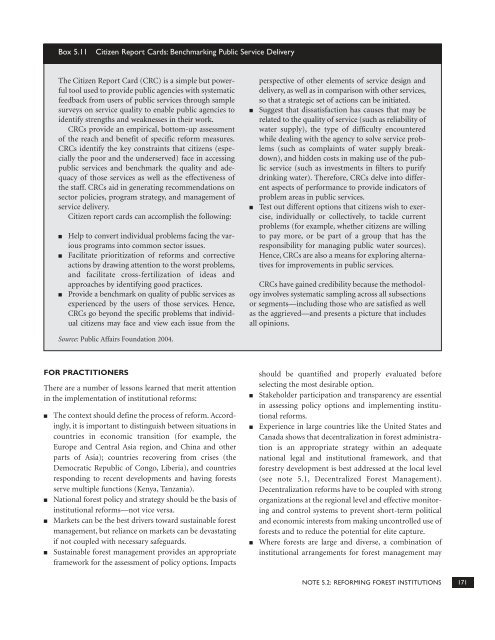Forests Sourcebook - HCV Resource Network
Forests Sourcebook - HCV Resource Network
Forests Sourcebook - HCV Resource Network
Create successful ePaper yourself
Turn your PDF publications into a flip-book with our unique Google optimized e-Paper software.
Box 5.11<br />
Citizen Report Cards: Benchmarking Public Service Delivery<br />
The Citizen Report Card (CRC) is a simple but powerful<br />
tool used to provide public agencies with systematic<br />
feedback from users of public services through sample<br />
surveys on service quality to enable public agencies to<br />
identify strengths and weaknesses in their work.<br />
CRCs provide an empirical, bottom-up assessment<br />
of the reach and benefit of specific reform measures.<br />
CRCs identify the key constraints that citizens (especially<br />
the poor and the underserved) face in accessing<br />
public services and benchmark the quality and adequacy<br />
of those services as well as the effectiveness of<br />
the staff. CRCs aid in generating recommendations on<br />
sector policies, program strategy, and management of<br />
service delivery.<br />
Citizen report cards can accomplish the following:<br />
■<br />
■<br />
■<br />
Help to convert individual problems facing the various<br />
programs into common sector issues.<br />
Facilitate prioritization of reforms and corrective<br />
actions by drawing attention to the worst problems,<br />
and facilitate cross-fertilization of ideas and<br />
approaches by identifying good practices.<br />
Provide a benchmark on quality of public services as<br />
experienced by the users of those services. Hence,<br />
CRCs go beyond the specific problems that individual<br />
citizens may face and view each issue from the<br />
■<br />
■<br />
perspective of other elements of service design and<br />
delivery, as well as in comparison with other services,<br />
so that a strategic set of actions can be initiated.<br />
Suggest that dissatisfaction has causes that may be<br />
related to the quality of service (such as reliability of<br />
water supply), the type of difficulty encountered<br />
while dealing with the agency to solve service problems<br />
(such as complaints of water supply breakdown),<br />
and hidden costs in making use of the public<br />
service (such as investments in filters to purify<br />
drinking water). Therefore, CRCs delve into different<br />
aspects of performance to provide indicators of<br />
problem areas in public services.<br />
Test out different options that citizens wish to exercise,<br />
individually or collectively, to tackle current<br />
problems (for example, whether citizens are willing<br />
to pay more, or be part of a group that has the<br />
responsibility for managing public water sources).<br />
Hence, CRCs are also a means for exploring alternatives<br />
for improvements in public services.<br />
CRCs have gained credibility because the methodology<br />
involves systematic sampling across all subsections<br />
or segments—including those who are satisfied as well<br />
as the aggrieved—and presents a picture that includes<br />
all opinions.<br />
Source: Public Affairs Foundation 2004.<br />
FOR PRACTITIONERS<br />
There are a number of lessons learned that merit attention<br />
in the implementation of institutional reforms:<br />
■<br />
■<br />
■<br />
■<br />
The context should define the process of reform. Accordingly,<br />
it is important to distinguish between situations in<br />
countries in economic transition (for example, the<br />
Europe and Central Asia region, and China and other<br />
parts of Asia); countries recovering from crises (the<br />
Democratic Republic of Congo, Liberia), and countries<br />
responding to recent developments and having forests<br />
serve multiple functions (Kenya, Tanzania).<br />
National forest policy and strategy should be the basis of<br />
institutional reforms—not vice versa.<br />
Markets can be the best drivers toward sustainable forest<br />
management, but reliance on markets can be devastating<br />
if not coupled with necessary safeguards.<br />
Sustainable forest management provides an appropriate<br />
framework for the assessment of policy options. Impacts<br />
■<br />
■<br />
■<br />
should be quantified and properly evaluated before<br />
selecting the most desirable option.<br />
Stakeholder participation and transparency are essential<br />
in assessing policy options and implementing institutional<br />
reforms.<br />
Experience in large countries like the United States and<br />
Canada shows that decentralization in forest administration<br />
is an appropriate strategy within an adequate<br />
national legal and institutional framework, and that<br />
forestry development is best addressed at the local level<br />
(see note 5.1, Decentralized Forest Management).<br />
Decentralization reforms have to be coupled with strong<br />
organizations at the regional level and effective monitoring<br />
and control systems to prevent short-term political<br />
and economic interests from making uncontrolled use of<br />
forests and to reduce the potential for elite capture.<br />
Where forests are large and diverse, a combination of<br />
institutional arrangements for forest management may<br />
NOTE 5.2: REFORMING FOREST INSTITUTIONS 171

















